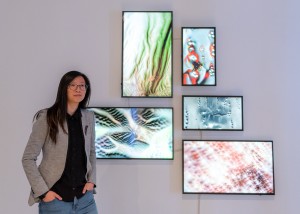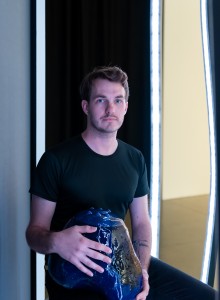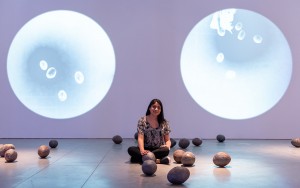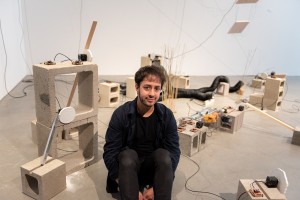Curators usually chide visitors for touching an artistic installation. But in “An Unreal Unity,” interaction is key.
The ongoing exhibition featuring work from graduating design media arts students will be displayed in the New Wight Gallery in Broad Art Center through Thursday. Jennifer Steinkamp, a design media arts professor, curated the exhibition and said the pieces showcase the culmination of the students’ learning and ideas since fall quarter.
Read about some of the featured installations below.
“Rock, Wealth, Kettle, Writing Brush, Pine”
Machine learning escaped its analytical usage in graduate student Hye Min Cho’s creation.

“Rock, Wealth, Kettle, Writing Brush, Pine” features five screens that each materialize images of one of the titular nouns. Cho said she trained a machine learning algorithm to classify photos into each of these five categories. She then inverted the typical usage of machine learning algorithms by having the machine output a series of images based on each specific noun.
“I’m going backwards using the same trained model,” Cho said. “I am asking it, ‘I would like a kettle, can you put (up a) distribution of images you associate to be a kettle and output the characteristics you consider to be a kettle?’”
The images themselves are 224 by 224 pixels, so Cho said she utilized between 50,000 and 100,000 pictures to generate each display in a manner that seems to animate the objects. Her inspiration came from East Asian still-life paintings from 100 years ago, which focused on capturing the spirit of an object in a two-dimensional space instead of emphasizing perspective. Cho said the machine learning algorithm is essentially capturing what it considers to be the most characteristic textures of each category to classify the photos.
[READ MORE: Art to Heart: Close encounters with contentious art challenge long-held conceptions, definitions]
Steinkamp said Cho’s background in computer science and electrical engineering is extraordinary in that it allows her to create her own software tools for her artwork.
“Looking back at my previous works, I was constantly exploring what it means for me to draw with computational technology,” Cho said. “I found machine learning to be a very natural extension from (my previous) techniques. And when I was choosing the objects (for the machine learning) I realized the analogy between machine learning and East Asian painting.”
“Buddy Party (Propositional Un-memberment for a Brighter Future)”
Male performers engaged with plaster-covered plastic bags in Sam Congdon’s installation the opening night of May 16. Now, only the cages and futuristic objects remain in the exhibit.

“Buddy Party (Propositional Un-memberment for a Brighter Future)” comprises three separate cages, each holding differently shaped plaster objects with which performers interacted. In one of the cages, a performer held a plaster object vaguely resembling a box, which supposedly contained his castrated genitals, Congdon said. Graduate student Congdon said his work portrays human interaction with technology – the more performers interacted with their plaster objects, the more they acted as if they were hypnotized by them.
Steinkamp said Congdon – or his alter ego, TOLVA – presented the performers as euphoric beings who carried artifacts from the future. Congdon said his work also served to explore queer futures, which critique masculinity. A queer future, Congdon said, is an imaginary future in which the lines defining typical gender roles are blurred. He showed this in his art by having a male performer nurture his object to challenge the stereotypically female act. Congdon said the idea of queer futures stems from the fact that queer culture has a different relationship with the future than other people. An example of this is the fact that queer people have a different relationship with making babies than other people, he said.
“This is another instance of me daydreaming and imagining futures that may be more powerful,” Congdon said. “(I’m) proposing queer futures as a way of critiquing the present and as a way of starting dialogue and conversations about the social and political forces in our world.”
“Vacuoles” and “Vacuoles II: Bioremediating cultures”
Maru García’s pieces allow viewers to physically join the bioremediation process of lead-contaminated soils.

“Vacuoles” consists of 29 ceramics taking the shape of plant organelles, each of them filled with contaminated soil from 29 areas in southeast Los Angeles. The ceramics lay on the gallery floor, while two walls display projections of the vacuoles alongside footage of the contaminated area.
The graduate student said a lead-battery recycling plant for the company Exide contaminated the soil in the collection areas. One solution for decontaminating the soil is to use plants that can absorb the lead from the soil and store it in their vacuoles, she said, which is why she chose to emulate the shape of the biological organelle.
Cameras installed above the vacuoles capture and project them onto the walls. When visitors stand near the vacuoles, their images are projected onto the wall as well.
García’s other installation features mustard plants in contaminated soil. A microscope records the bioremediation process live and projects it onto the wall sitting behind the plant. The projected vacuoles are superimposed onto the live feed, and visitors can see themselves in the projection when they walk near the ceramic vacuoles.
Steinkamp said García comes from a background in biotechnology and chemistry and is able to blend her scientific interests with incredible aesthetics.
“a room that i take care of”
A complex, natural system interconnected by wind sits on the opposite end of the gallery from García’s work.

Graduate student Julian Stein said his artwork, “a room that i take care of,” explores the subtle and sometimes imperceptible connections in different natural systems.
[READ MORE: Interdisciplinary art installation displays symbiosis of people, nature]
In Stein’s rendition of a natural system, a sensor moving along a skewer is able to change the force of the wind, and the motion of strands of grass can change the rate at which cogs rotate.
These cogs made from plaster and cement produce sound when they rub against wood or other materials in the system. This friction-driven noise imitates stridulation – the process through which crickets create sound waves when they rub their legs together.
He said each element in a natural system is perturbed by another and then continues on its path. Stein said capitalism is an example of this complex interconnectivity in a social setting. He said individuals themselves cannot fully understand these large-scale systems. Thus, it is difficult to imagine alternatives or solutions to their problems.
“There are some very powerful systems (in society) that are not necessarily understandable,” Stein said. “The idea of this is, by making systems physical, perhaps we can understand them, by materalizing them.”
